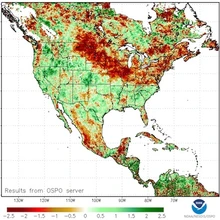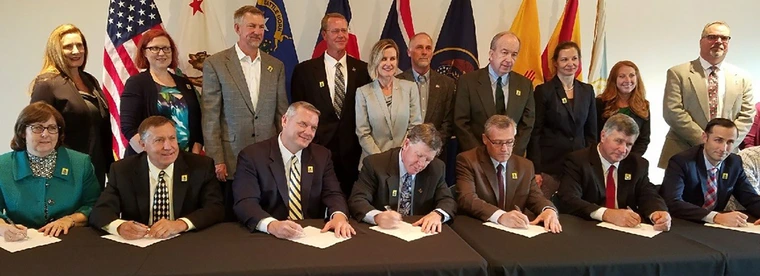SRP Reservoirs Rebound after Wet Winter
Healthy winter snow and rain in Arizona helped fill Salt River Project (SRP) reservoirs in Central Arizona. This winter broke a six-year streak of lower than average runoff. As Jeffrey P. Lane reported in August, all reservoirs on the Salt River except Roosevelt Lake were full in early spring. Reservoirs on the Verde River reached capacity in February, so that it was necessary to spill water and continue the releases through late spring. With a total of about 970,440 acre-feet of runoff, the SRP system recovered from 49 percent of capacity last year to 68 percent of capacity as of August 23, 2017. Current reservoir levels can be found online through the SRP website at http://data.hydrometdataservice.info/dwr/report.aspx?dt=10/3/2017.
New SRP Website Offers Watershed Information
Anyone thinking of taking advantage of recreational opportunities in the Salt and Verde River watershed can now check out hydrologic and meteorological conditions on the Salt River Project’s new website: WatershedConnection.com. The site replaces and expands a previous information source, WatershedMonitor.com, creating a user-oriented portal for learning about the watershed and SRP’s role in its protection and management.
Large Study Finds Plastic in Drinking Water Worldwide

Plastic is used in practically all aspects of life and now it has been found in drinking water. Orb Media and a researcher with the University of Minnesota School of Public Health, conducted a massive study, collecting samples from five different continents, and found that more than 80 percent of the samples contained plastic fibers. In the United States, that percentage was more than 90 percent, on par with Beirut, Lebanon. These plastic microfibers come from a variety of sources, including clothing, paints, and dust from tires. The fibers find their way into water sources and eventually come out the tap in drinking water. What’s more, the microfibers find their way into food as well through irrigation and then moving up the food chain. Is this a concern? Apparently, this is an unanswered question. According to Orb Media, plastic microfibers are known to absorb chemicals from their environment. When the body attempts to digest these materials, these chemicals are released into the body. In addition, plastic microfiber can break down into particles so small that they can move through the intestinal wall. Upgrading water treatment to nanofiltration or reverse osmosis could prevent plastic microfibers from entering drinking water, but this is an expensive option. Orb Media has posted a report of their research at https://orbmedia.org/stories/Invisibles_plastics/multimedia , where they advocate for reducing the use of plastics and recycling those plastic items we do use.
Flash Drought Prediction Enhanced and Expanded

The rapidly developing drought in the upper Midwest this summer called attention to improving drought prediction capabilities. A satellite data based tool has proven useful in predicting “flash droughts”, those periods of abnormally low precipitation and high temperature that lead to a rapid decrease in soil moisture. The tool, Evaporative Stress Index (ESI), became operational in 2016. Christopher Hain, the project leader, worked with a multi-agency team beginning in 2008, which included the U.S. Department of Agriculture, National Aeronautics and Space Administration, the National Oceanic and Atmospheric Administration, and others. ESI has detected indicators of drought much earlier than conventional monitors, and it excels at recognizing and predicting flash droughts. It has already proven its usefulness to farmers and ranchers in the United States. Based on assessment of ESI’s functionality, the development team is expanding ESI to global datasets for use worldwide. Most effective when used in conjunction with other information sources, its unique utility is its ability to reduce the lag times of other monitors. One route to the ESI is through https://www.climate.gov/maps-data/dataset/evaporative-stress-index-maps….
Binational Cooperation Yields Agreement on Colorado River

As September came to a close, the International Boundary and Water Commission convened representatives of the United States and Mexico for the ceremonial signing of Minute 323 to the 1944 Water Treaty between the nations. Minute 323 extends the provisions of Minute 319, which was signed in 2012 and set to expire at the end of 2017. It retains the previously agreed upon annual increases and annual cutbacks in water allocation to Mexico based upon water levels in Lake Mead. In addition, it adopts a Binational Water Scarcity Contingency plan, which depends on achievement of the water saving described in the Lower Basin Drought Contingency Plan and lays out the terms of Mexico’s participation. It also continues Mexico’s option to defer delivery and store portions of its Colorado River water entitlement in Lake Mead and establishes a revolving account and Intentionally Created Mexican Allocation. Minute 323 also extends provisions of Minute 242, which deals with salinity control measures for water delivered to Mexico. To deal with the variability of flows arriving in Mexico, a pilot program and operational review will be undertaken at Morelos Dam, which should lead to less variability in daily flow.
Regarding the environment, provisions of Minute 319 are extended and augmented. River water, in the amount of 210,000 acre-feet, was pledged for environmental purposes, one-third each from Mexico and the United States and one-third from a binational coalition of NGOs. In addition, funds will be provided: $9 million for research and monitoring and $9 million for restoration projects. The U.S. commitment of 70,000 acre-feet will be met with water conserved with the $31.5 million the United States will invest in water conservation projects in Mexico. Additional water conserved through these projects will be allocated to Mexico, except for amounts reserved for the system, benefiting all users, and for the United States. New water source projects, such as desalination and treated effluent reuse, are included along with conservation projects for long-term protection of Colorado River flows. Binational working groups defined by Minute 323 will be active for the duration of the agreement—through 2026—investigating and monitoring implementation.

